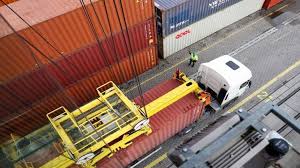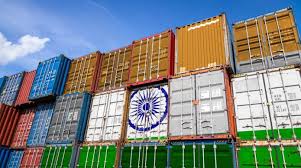India’s exports have long been a cornerstone of its economic growth story, serving as a vital engine for job creation, foreign exchange earnings, and industrial development. However, in recent times, the pace of India’s export growth has exhibited a decelerating trend, raising concerns among policymakers, economists, and industry stakeholders alike. This essay aims to delve into the multifaceted reasons behind India’s slowing exports, examining both domestic and external factors that have contributed to this phenomenon and exploring potential strategies to revitalize India’s export performance.
- Global Economic Headwinds: One of the primary factors contributing to India’s exports is the challenging global economic environment characterized by trade tensions, geopolitical uncertainties, and subdued demand in key export destinations. Escalating trade conflicts between major economies, such as the United States and China, have disrupted global supply chains, dampened investor sentiment, and exerted downward pressure on global trade volumes. Moreover, geopolitical tensions, geopolitical tensions, and the resurgence of protectionist policies in certain regions have further exacerbated market uncertainties, constraining India’s exports opportunities for Indian businesses.
Furthermore, the lingering effects of the COVID-19 pandemic have inflicted severe disruptions on global trade flows, leading to supply chain bottlenecks, logistical challenges, and subdued consumer demand in several economies. The pandemic-induced economic slowdown, coupled with ongoing supply chain disruptions, has weighed on India’s exports performance, particularly in sectors reliant on global demand and cross-border trade.
- Structural Bottlenecks and Policy Constraints: India’s exports slowdown is also reflective of underlying structural bottlenecks and policy constraints that impede the competitiveness and efficiency of its export-oriented industries. Despite efforts to improve the ease of doing business and streamline regulatory processes, Indian exporters continue to grapple with bureaucratic hurdles, cumbersome procedures, and infrastructure deficiencies that undermine their ability to compete effectively in global markets.
Inadequate infrastructure, including ports, roads, and logistics networks, adds to the transaction costs and lead times associated with exporting goods, thereby eroding the competitiveness of Indian products vis-à-vis their global counterparts. Additionally, regulatory complexities, including compliance requirements, export documentation, and taxation issues, impose administrative burdens on exporters, hindering their ability to leverage export opportunities and expand market access.
Moreover, policy ambiguities and inconsistencies, including frequent changes in export incentives, tariff structures, and trade policies, create uncertainty for exporters and inhibit long-term investment planning and export-oriented strategies. A coherent and stable policy framework that fosters a conducive business environment, promotes export diversification, and addresses structural bottlenecks is imperative to unleash India’s export potential and propel its integration into global value chains.
- Exchange Rate Dynamics and Competitiveness Challenges: The exchange rate dynamics play a pivotal role in influencing India’s export competitiveness and trade performance. A persistently strong Indian rupee relative to major trading currencies, such as the US dollar and euro, can erode the price competitiveness of Indian exports in international markets, making them relatively more expensive for foreign buyers. Conversely, a depreciating rupee can enhance export competitiveness by lowering the cost of Indian goods for foreign buyers, stimulating export demand and enhancing export earnings.
However, India’s exchange rate policy and management have faced challenges in maintaining a delicate balance between promoting export competitiveness and ensuring macroeconomic stability. Central bank interventions in the foreign exchange market, capital inflows, and external shocks can introduce volatility and unpredictability in the exchange rate, complicating export planning and pricing strategies for businesses.
Furthermore, structural factors such as high production costs, inefficiencies in the manufacturing sector, and labor market rigidities contribute to India’s competitiveness challenges, limiting the ability of Indian exporters to capitalize on export opportunities and penetrate global markets effectively. Addressing these structural constraints through policy reforms, investment in human capital, and enhancing productivity and innovation is crucial to enhancing India’s export competitiveness and sustaining export-led growth.

- Sectoral Composition and Export Diversification: India’s export slowdown is also influenced by the sectoral composition of its exports and the degree of export diversification across industries. While India has demonstrated strengths in certain sectors such as information technology (IT) services, pharmaceuticals, and textiles, its export basket remains relatively concentrated, with a few sectors dominating the export landscape. Overreliance on a limited number of sectors exposes India’s export earnings to sector-specific risks and vulnerabilities, limiting the resilience and diversity of its export portfolio.
Moreover, the sluggish performance of traditional export sectors, such as gems and jewelry, leather goods, and engineering goods, further compounds India’s export woes, as these sectors face structural challenges, supply-side constraints, and shifting global demand patterns. Diversifying India’s export base by nurturing emerging sectors with high growth potential, promoting value-added manufacturing, and leveraging technology and innovation can enhance the resilience and competitiveness of India’s exports, enabling the country to navigate evolving global trade dynamics more effectively.
Read Also: India’s Mobile Manufacturing Industry: The Best New Export Growth 2024
Conclusion: In conclusion, India’s slowing exports are influenced by a complex interplay of global economic headwinds, structural bottlenecks, policy constraints, exchange rate dynamics, and sectoral composition issues. Addressing these challenges requires a concerted effort by policymakers, industry stakeholders, and other relevant actors to implement targeted reforms, streamline regulatory processes, enhance infrastructure, and foster a conducive business environment for exporters.
Moreover, promoting export diversification, investing in skill development and innovation, and leveraging digital technologies can unlock new growth opportunities and enhance India’s competitiveness in global markets. By addressing the underlying constraints and tapping into its inherent strengths and potential, India can revitalize its export performance, bolster economic growth, and achieve greater integration into the global economy.

